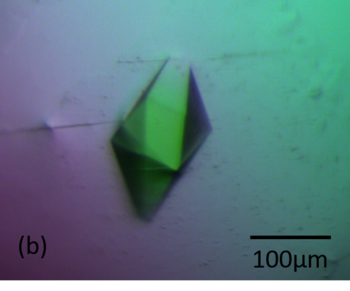Journal:IUCrJ:S2052252521005340
From Proteopedia

X-ray crystallography studies of RoAb13 bound to PIYDIN, a part of the CCR5 N-terminal domainLata Govada, Emmanuel Saridakis, Sean C. Kassen, Ahmad Bin-Ramzi, Rhodri Marc Morgan, Benjamin Chain, John R. Helliwell and Naomi E. Chayen [1] Molecular Tour Anti-HIV antibody RoAb13 targets a short N-terminal region of the protein CCR5, which is the main entry receptor of HIV into the human organism. Blocking that receptor would therefore prevent HIV infection and replication. We had earlier reported the structure of the antibody alone by X-ray crystallography (Chain et al. 2015[2]), but the structure of the antibody complexed to the part of CCR5 to which it binds (its epitope) had remained elusive. That structure is important for designing efficient vaccines based on short synthetic immunogenic peptides that mimic the CCR5 antibody-binding region. After a long search for co-crystallization conditions involving both the whole N-terminal region of CCR5 and the minimally required binding region to its antibody (the ‘core peptide’), and the analysis and comparison of X-ray crystallographic electron density maps obtained from several crystals, we have finally located the core peptide of the CCR5 receptor bound to RoAb13. It binds at the hypervariable region ‘CDR3’ of the antibody’s light chain, an expected antigen-binding site. In spite of the fact that the best attainable resolution is not particularly high at 3 Å, we have been able to identify the interacting residues between antibody and peptide PIYDIN (both cases). The PIYDIN of the 31 peptide study; PIYDIN is colored in orange, antibody RoAb13 in cyan/green. We observe that, in the case of the PIYDIN part of the 31 peptide, Pro8 of the ligand is near (approximately within 3.5 Å of) tyrosines 98 and 100, and Ile12 near Tyr98 of the Light chain. Tyr10 of the ligand comes near Asp61 and Arg64 of the Heavy chain. Asp11 is only engaged in intra-peptide interactions, with Ile12 and Asn13. In the PIYDIN only study, Ile9 (in hot pink) additionally comes near Thr99 (in deep sky blue) of the Light chain. The corresponding distance is ca. 5 Å for the 31 peptide structure (Ile9 is in orange; Thr99 in cyan). PIYDIN is colored in magenta, antibody RoAb13 in cyan/green. The PIYDIN of the 31 peptide study (Figure 2a): The PIYDIN only study (Figure 2b): The overlay of both with the 31 peptide; the peptide is not in exactly the same placement but very similar (Figure 2c):
Furthermore, the core peptide was found to bind in a way that can accommodate the full length of the CCR5 N-terminus. The structural insights thus may inform the design of better peptide analogues for use as immunogens in vivo. These analogues may ultimately provide the basis for active immunization vaccines to stimulate an antibody response to native CCR5 which will thwart HIV infection. PDB references: RoAb13, bound to 31-residue peptide containing the PIYDIN sequence, 7njz; bound to PIYDIN peptide, 7nw3. References
|
| ||||||||||



